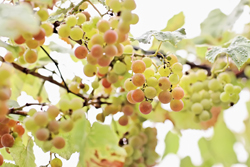Mapping toxic fungi in grapes
Aspergillus section Nigri, particularly the species Aspergillus carbonarius is the toxic fungus commonly known as black mould. It is present in soil and is a common contaminant of food attacking a variety of fruits and vegetables such as grapes, onions and peanuts as well as coffee beans. Furthermore it is responsible for producing the mycotoxin OTA (Ochratoxin a) which is considered to be a human carcinogen. The WINE-OCHRA RISK project identified and characterised populations of OTA producing fungi present in grapes and wine. The infection cycle of these strains, particularly in relation to their ecological requirements, was closely examined. This way, sources of contamination could be pinpointed in the hope of formulating preventative action. A significant correlation was found between geographical coordinates and the incidence of berries being infected by black Aspergiili at early stages as well as at the ripening stage. In fact, a positive link was shown with longitude for both Aspergillus niger and A. carbonarius. Prediction maps were created for Spain, Portugal, Israel, Italy, France and Greece spanning the course of a few years. The findings could be useful for corrective action during grape storage and/or processing.







